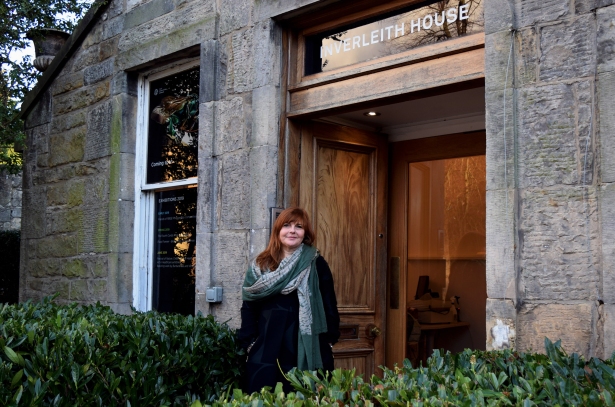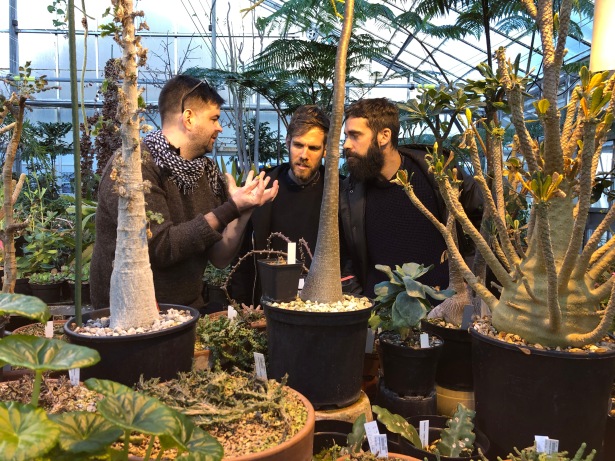
Emma Nicolson, Head of Creative Programmes, Royal Botanic Garden Edinburgh (RBGE), kindly agreed to be interviewed for ecoartscotland. The interview happened by email during July 2020 and is focused by the reinvention of Inverleith House as ‘Climate House’, moving beyond the 20th century idea of the gallery as ‘white cube’ and reconnecting with the context of the Botanic Gardens. This new approach is happening alongside a collaboration with the Serpentine Galleries in London, developed as a result of match-making by Outset Partners.
Chris Fremantle (CF): Can you tell us a bit about what Inverleith House will be like once it is ‘Climate House’?
Emma Nicolson (EN): We are confronting a pivotal moment in the role of the arts within Royal Botanic Garden Edinburgh (RBGE). Climate House reimagines Inverleith House as a gallery for the 21st century, igniting a new arts strategy across the Garden, and establishing RBGE as a visionary institution within Climate Crisis.
This marks the beginning of a three-year vision for Climate House which will act as a pilot project to be reviewed after that time. It’s underpinned by ‘By Leaves We Survive’, a new arts strategy for Royal Botanic Garden Edinburgh. We are focusing on the ‘21st century explorer’, inspiring discoveries between artists, scientists, horticulturists, scholars, activists, entrepreneurs, policymakers and visitors and local communities.

The Climate Crisis (and the pandemic) isn’t the first crisis for RBGE. RBGE was established in 1670 during an era of famine, plague and witch trials, by two physicians Robert Sibbald and Andrew Balfour. Their vision was to create a garden that would supply the apothecaries and physicians of Edinburgh with medicinal plants to help improve the wellbeing of the people of Edinburgh.
Now, four centuries later, our vision is to transform Inverleith House into Climate House – an institute for ecology at the edge, reconnecting our gallery both to its roots as a centre for medical innovation and its future as a hub that will promote the synergy between art and science as we face one of the most significant challenges of the 21 century.
Climate House will be an intimate place for contemporary art that is embedded within the natural world. The physical manifestation of Climate House is not set in stone, conceptually it will be a place to explore the future of our planet through art.
CF: What will we experience?
EN: My vision for Climate House is that it will be a place you want to dwell in, as soon as you step into the building you get a sense of a warm welcome, a sense of home for art.

For those not familiar with Inverleith House, it has a rich history of displaying modern and contemporary art. Originally built as a house for Sir James Rocheid, a prominent agriculturalist of the 19th Century. The house and a portion of his land was sold to the Royal Botanic Garden Edinburgh in 1877. The house then became the home to the Regis Keeper of the gardens. In 1960, the house was turned into the inaugural home of the Scottish National Gallery of Modern Art and in 1986 it became the official art gallery of the Botanic Garden developing a renowned exhibition programme of contemporary and botanical art.
Despite Inverleith House’s deep historic relationship to the gardens it has become untethered from the organisation’s wider activities in recent years. Isolated in part by the 20th Century approach to displaying contemporary art. We want to move on from the ‘white cube’ of yesteryear, taking a different tack that reconnects the house to its surroundings, but also to transform the house into a gallery fit for the pressures and urgent challenges of the 21st century. The most pressing of which is the Climate Crisis. Inverleith House’s proximity to the world of plants; the richness of scholarship, inquiry and praxis associated with RGBE means we have resources at our disposal to begin to think about the role of a gallery in the age of Climate Crisis. Art and culture have a valuable and important part to play in linking objects, images, processes, people, locations, histories and discourse in a physical space to open up dialogues and imaginaries that we see as critical to connecting audiences to this crisis.
Our plan is to work with artists like Christine Borland, Cooking Sections, and Keg de Souza to transform Inverleith House into a Climate House and create a new vision. Inverleith House is a house in a botanic garden; a garden made for explorers of the past. We want to transform Inverleith House into a home. A home for the 21st century explorer. This explorer listens to the voices less heard, refuses to conform to the boundary between culture and nature, and is willing to imagine ways of living for the future.
A key area of focus for our work will be around listening to voices less heard. These might include indigenous peoples and women in science. RGBE’s Collection grew with the British Empire and our work still operates in many geographies across the globe in doing vital work in the areas of conservation. There is also historical amnesia about women’s role in the study of plants. I want to unearth these stories and put them front and centre of our programme. However, I recognise that often the stories that just lurk below the surface tend to be that of privileged women from the upper classes. Although these stories are valid and worth sharing we also acknowledge that we need to dig deeper to unearth the stories of working-class and indigenous women who have contributed to the knowledge of our natural world.
CF: Will we visit Climate House to see different artists’ work or will we mostly interact with Climate House as an environment centre?
EN: We will explore the overlapping boundaries between visual arts, architecture and geopolitics. I want to think about how we present sound, live art, dance, performance and music, fashion, and the creative industries as well as internationally important visual art. And beyond this how do we work with resources, the buildings, knowledge, expertise, networks for the greater benefit of Edinburgh, Scotland and beyond.
Climate House is being built on the core principles of Sustainability, Collaboration, Intimacy and Attentiveness. Through these values we want to play with the scales of domesticity, creating intimate connections to the globally threatening phenomena of Climate Crisis. I was very inspired by the work of Maria Puig de la Bellacsa’s and her book ‘Matters of Care, Speculative Ethics in More than Human Worlds’. To do this, we will connect the wealth of expertise in RGBE’s activity and its collections: the Living collection; the Herbarium (some 3 million specimens); and the Archive (the historical collection) to artists and audiences. Our aim is to lead a society-wide journey towards a worthwhile future where surprising discoveries can happen and meaningful impact is achieved.
Sustainability: The mission of RBGE is to “explore, conserve and explain the world of plants for a better futureâ€. In executing this mission, we must acknowledge the Climate Crisis and think of ways that the gallery can respond through our programming and operational endeavours. These considerations may be formed through advocating the value in artistic practice in imagining “a better futureâ€. This sees us leading in best practice in how we work with artists, by valuing their contributions and paying them appropriately and responsibly. It includes how we think about materials and waste in the conceiving and mounting of exhibitions and projects. Sustainability also means thinking robustly about our relationships beyond the gallery and the garden and how we connect to conversations and activities society-wide. As director of ATLAS we were a member of Creative Carbon Scotland’s Green Arts Initiative and considered climate impact of everything we did this is something I hope to implement at RBGE through Climate House. There is a lot of valid discussion right now about the need for hyperlocalism or to find ways of reducing our carbon footprint and to be inventive with our programming.
Collaboration: Working with others is vital to how we operate. The house is situated amongst a rich and vital community of scholarship and scientific research. It is our aim to connect scholars, scientists, activists, entrepreneurs and artists together to explore, interpret and discuss our natural world. For example, we have already initiated several internal gathering and sharings with artists and RBGE specialists in science and horticulture. This has included Christine Borland who is looking at the story of flax in Scotland and Cooking Sections who are engaged with Scotland’s forest landscape transformation and food production.



Intimacy: Using the home as our inspiration we want to explore intimate stories. To think about the domestic setting and how this model can be applied to an art gallery. Through an informal approach, informed by closeness. We want to create spaces of retreat and relaxation, warmth and comfort. But also spaces to discuss how we imagine living together in times of Climate Crisis. To challenge the idea of the idyllic home and instead welcoming the unruly edges in to create a space to hold many voices that is not alienating and open to all.

Attentiveness: This value demands rigour, a way of working that pays close attention to something. We are attentive to our context – the deep and rich history of the gardens and its contemporary activities. We are attentive to our artists making sure that we deploy support structures that enable the artist to develop their practices in new and challenging ways. We are attentive to our audiences, creating situations and experiences that resonate, inspire and inform our audiences of the world around them.
CF: What are you bringing from your work at ATLAS to ‘Climate House’?
EN: There is a lot of my work with ATLAS I see as relevant to this role, although very different, but a key aspect would be the importance of understanding your context and building connections to create engagement, this is always at the core of what I do! I also really believe in artists as agents for change – they help us re-imagine the future, see things differently and move minds. They help provide an emotional connection to some of the difficult topics and concepts that our scientists are exploring. I think it is important to form long term relationships with artists that allows work to evolve over time. I hope to bring some of the artists whose practice I believe has the capacity delve deeply into the work of RBGE inspiring, challenging, engaging and igniting our audiences.
CF: And can you tell us a bit more about Keg de Souza’s role and how they will be contributing to the development?


EN: We are delighted to be working with interdisciplinary artist Keg de Souza as part of Climate House. De Souza has previously had major exhibitions in Melbourne, New York, Vancouver and London, and is known for her socially engaged art practice, using mediums such as inflatable and temporary architecture, food, video, text, illustration, mapping, and open dialogue projects to explore the politics of space. Her work often brings communities from around the world together through active citizenship and situation specific projects, with an emphasis on cultures, inclusivity, displacement, shared knowledge, and questioning established methods of learning. The understanding that de Souza, as a woman of colour, and her potential collaborators will bring to Climate House around identity and Indigenous Knowledge will be particularly impactful for all communities involved. When looking for ways of living for the future, we may find answers long embedded within Indigenous culture and histories, and Australia, where de Souza is based, is more advanced in this respect. De Souza has previously worked with the Australian Indigenous writer Bruce Pasco on displacement of Indigenous food cultures in Australia. Pascoe’s ‘Dark Emu’, for instance, reassess the ‘hunter-gatherer’ label given to pre-colonial Aboriginal Australians, evidencing that Aboriginal people right across the continent were using domesticated plants, sowing, harvesting, irrigating and storing. De Souza points to contemporary work being carried out to share knowledge, ideas and experience we hope that her insights will ignite new research and debate.
CF: It is being called ‘Climate House’ and it’s located in one of the main biodiversity organisations in the world – when you talk about ‘Climate House’ what will it encompass? What does ‘Climate’ encompass for you?
EN: Whilst RBGE is home to crucial research related to climate change adaptation and biodiversity, we have not been able to engage with this work in great enough depth within our arts programme thus far, nor share it creatively with our audiences. Likewise, we have not had the opportunity to hear what our audiences have to say about the climate emergency. Time is running out, the current Covid-19 pandemic has brought into sharp focus for many the need to revaluate our relationship to the environment and to respond to the Climate Emergency and Biodiversity Crisis. With this increased awareness people are seeking answers. The latest United Nations Intergovernmental Panel on Climate Change report predicts that we have less than 10 years to significantly reduce carbon emissions if we are to avoid the worse consequences of climate change.
Because of the Garden’s relationship to plant science and showcasing the value of the natural world, it is inherently well placed to lead the way in addressing climate change in all the work we do and this includes helping our staff, volunteers and audiences to take similar steps at home however small. We already have sustainable practices across the Garden that includes; water saving, rain garden, recycling, composting, sustainable food sourcing and avoiding food waste. We want to share our knowledge with audiences that will encourage them to take their own steps towards sustainability and climate action. So I am thinking of ‘Climate’ in the most general of ways, interconnected with everything we do.
CF: How is the partnership with the Serpentine Gallery going to work? Some people have suggested that it will be like V&A Dundee – an outstation model?
EN: To receive the Outset Contemporary Art Fund’s Transformative Grant, in partnership with the Serpentine, presents a momentous opportunity to focus on the desperate nature of our planet’s plight.
This year will be one of transition. Exploring new ways of working with different kinds of partners including the Serpentine, ensuring that the changes I want to make have time and space to take root so that we grow the new Climate House on solid ground. We were recently successful in being awarded an Art Fund Networking grant which will help us form the General Ecology Network a key part of our collaboration with the Serpentine. We have no concept of being an outstation. The two organisations operate as separate entities but will work together in partnership. Currently I am working with Lucia Pietroiusti, the Serpentine’s Curator of General Ecology, and we are sharing knowledge, ideas and artists and hope to come together with our programming where appropriate for example we recently cocurated a Serpentine Podcast featuring artists from Back To Earth and Climate House. Over the coming weeks we will begin to define ways in which this collaboration can unfold, and we have already identified several avenues that we will be exploring. The programme will be geared very much towards developing artistic and curatorial practice.
Through the General Ecology Network we intend to access those at the very forefront of ecological concerns and in turn share this with peers and artists who can provide citizens of all generations and backgrounds with opportunities to discover, explore and engage with this vital field of knowledge. We envisage this happening through a range of public programmes, events, podcasts, meetings, skills exchange and workshops. And – given the current pandemic situation and social distancing guidance – we are currently reviewing how these programmes will take place and identifying the best possible digital platforms and practitioners we might want to employ. Sitting with a garden in a park both our institutions have these incredible spaces as assets and we are talking about how we can take art outside, inviting audiences to engage with our programmes beyond the gallery walls.Â
This immediate goal for the General Ecology Network will then allow content we create to be transformed into tools that can be shared more broadly both across the sector and with the public. We will focus on creating access to new and specialist knowledge, opening up conversations, and sharing new perspectives on the on-going debate on climate emergency and biodiversity crisis.
——
ecoartscotland is a resource focused on art and ecology for artists, curators, critics, commissioners as well as scientists and policy makers. It includes ecoartscotland papers, a mix of discussions of works by artists and critical theoretical texts, and serves as a curatorial platform.
It has been established by Chris Fremantle, producer and research associate with On The Edge Research, Gray’s School of Art, The Robert Gordon University. Fremantle is a member of a number of international networks of artists, curators and others focused on art and ecology.
Powered by WPeMatico


